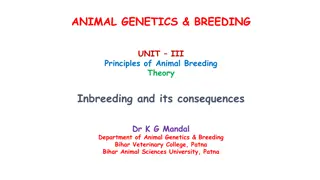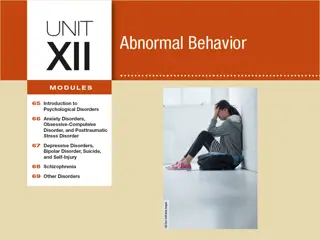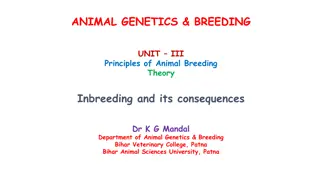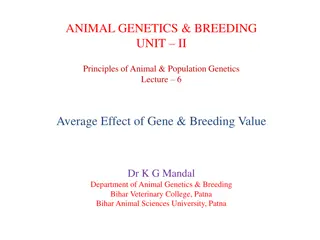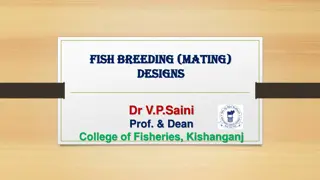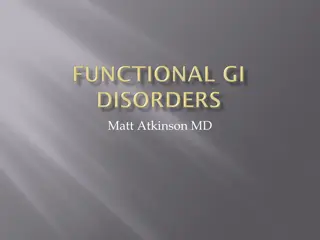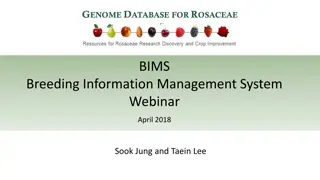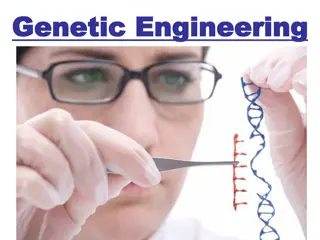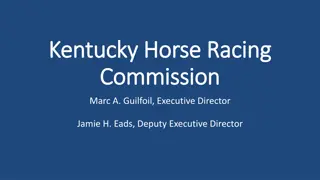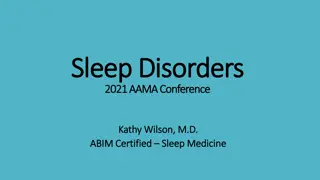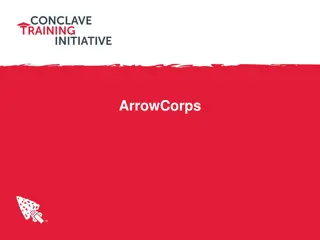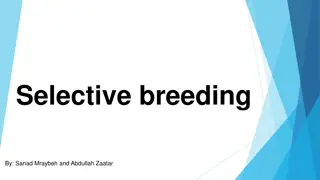Monogenetic Disorders in Noriker Horses: Implications for Conservation Breeding Programs
This study explores monogenetic disorders, specifically PSSM Type1, in Noriker horses, highlighting the impact of GYS1 gene mutation on breeding practices. The research delves into carrier frequencies across diverse horse breeds and emphasizes the importance of genetic screening in conservation breeding efforts to preserve endangered horse breeds like the Noriker.
Download Presentation

Please find below an Image/Link to download the presentation.
The content on the website is provided AS IS for your information and personal use only. It may not be sold, licensed, or shared on other websites without obtaining consent from the author.If you encounter any issues during the download, it is possible that the publisher has removed the file from their server.
You are allowed to download the files provided on this website for personal or commercial use, subject to the condition that they are used lawfully. All files are the property of their respective owners.
The content on the website is provided AS IS for your information and personal use only. It may not be sold, licensed, or shared on other websites without obtaining consent from the author.
E N D
Presentation Transcript
Monogenetic disorders and their implications for conservation breeding programs a practical example from the Noriker horse breed T. Druml und G. Brem 27th DAGENE Meeting 22nd to 24th April 2016 Institut f r Tierzucht und Genetik
PSSM Polysaccharide storage myopathy Firstly documented by Valberg 1992 in 9 Quarter Horse related horses In 1997 PSSM firstly was diagnosed in 8 Draft horses (age 2 to 21 years) Diagnosis: 1. Histology 2. Clinical Symptoms Quarter Horse: severe Symptoms, severe rhabdomyolysis, inability to rise in combination with RYR1 Gene Warmblooded horses: muscleatrophy, back problems Draft horse: overt weakness, muscleatrophy and training- intolerance
GYS1 gene mutation Based on muscle histology PSSM Type1 was associated with a point mutation in the GYS1 gene by McCue et al. in 2008 Association of the mutation with PSSM Type1 ranging from 65% to 87% Mutation was detected in a big variety of breeds (Quarter Horse, Warmblooded horses, Draft horses, Ponies) Age of the mutation is 1.200 to 1.500 years In 2010 the gene test was patented and is commercially promoted - effects on breeding of endangered horse breeds draft horses
Screening for the GYS1 mutation in draft horses Carrier frequencies in diverse horse breeds 1McCue; 2Schwarz et al. 2011; 3Van der Hoven 2013; 4Larcher et al. 2008 breeds Quarter Horse1 Percheron1 Belgier1 Shire Horse1 Clydesdale1 Trekpaard1 Comtois1 Breton1 Haflinger2 Haflinger3 Noriker3 Cob Normand4 Number GYS1 carrier/N 22/335 93/149 58/149 1/195 0/48 17/23 70/88 32/51 9/50 25/108 43/130 20/53 Carrier freq.% 6.6 62.0 39.0 0.5 0.0 74.0 80.0 63.0 18.0 23.0 33.0 38.0
GYS1 genotype frequencies Noriker In total 2166 Noriker horses (1.649 foals; 208 breeding stallions; 309 breeding mares) were typed in 2014 for the GYS1 locus Carrier freq. ranging from 0.16 to 0.40 Number of genotyped Noriker foals born in 2013 and 2014 structured by coat colour and Gys1 genotype and carrier frequencies. N 0 1 2 16 35 4 11 Carriers 0,32 0,40 0,33 0,29 0,21 0,16 0,32 Bay Chestnut Roan Black Tobiano Leopard spotted 424 434 86 535 29 141 1649 288 260 58 378 23 119 1126 120 139 24 146 6 21 456 1 67
GYS1 genotype frequencies Noriker GYS1 carrier frequencies ranging from 4% to 62% in 518 breeding animals (stallions!) Number of genotyped Noriker breeding stallions and mares structured by coat colour and Gys1 genotype and carrier frequencies. Carrier stallions 0,38 0,62 0,32 0,31 0,20 0,04 Carrier mares 0,33 0,54 0,21 0,26 - 0,17 N 0 88 42 28 145 4 36 343 1 41 50 9 52 1 3 156 2 6 7 1 5 Carrier tot. 0,35 0,58 0,26 0,28 0,20 0,08 0,44 Bay Chestnut Roan Black Tobiano Leopard Sp. 135 99 38 202 5 39 518 19
GYS1 genotype frequencies Noriker 0.7 0.6 0.5 0.4 foals foals mares stallions mares 0.3 stallions 0.2 0.1 0 Bay Chestnut Black Roan Leopard Bay Chestnut Black Roan Leopard sp.
GYS1 and inbreeding and gene pool Mean inbreeding structured by coat colour cohorts and GYS1 genotype for foals born in 2014 0 1 2 Bay Chestnut Roan Black Tobiano Leopard spotted 4,92 6,05 4,70 4,89 4,68 4,88 5,12 6,34 4,43 4,75 4,56 4,29 4,54 6,81 4,58 5,00 Inbreeding effect Purging effect 2,84 Gentic diversity parameters for the foal cohort of the year 2014 structured by coat colour effective founders 112 120 88 125 104 115 effective ancestors 45 25 32 32 37 42 50% Gene pool explained by n= 18 9 12 12 14 16 N founders 1046 636 734 581 816 839 All Leopard spotted Chestnut Roan Bay Black 1560 136 335 87 424 535
GYS1 genotype frequencies stallions sire lines GYS1 genotype frequencies in 169 active Noriker breeding stallions by sire line Carrier frequency 0,68 0,13 0,24 0,52 0,35 0,38 N stallions in % 0 1 2 Diamant Elmar Schaunitz Nero Vulkan 22 24 25 33 65 169 0,13 0,14 0,15 0,20 0,38 1 7 21 19 16 42 105 14 3 6 14 20 57 1 3 3 7 Carrier frequency in all breeding stallions (0.38 ) is higher than the overall mean (0.32) Diamant sire line 68% carriers! Elmar sire line (traditional Leopard spotted sire line) lowest carrier (13%) proportion GYS1 is mostly segregating in chestnut families involving chestnut Diamant and Nero stallions
Genpool chestnut 15.2% of genes from carriers Gen- anteil 10,05 7,55 6,43 5,34 4,90 4,04 3,45 3,32 3,15 2,93 2,44 2,39 2,26 2,03 1,87 1,76 1,68 1,39 1,33 0,99 Genan- teil kum. Name 0,10 0,18 0,24 0,29 0,34 0,38 0,42 0,45 0,48 0,51 0,54 0,56 0,58 0,60 0,62 0,64 0,66 0,67 0,68 0,75 R 1 2 3 4 5 6 7 8 9 10 11 12 13 14 15 16 17 18 19 25 Vater Steindorf Vulkan X Neukirchen Vulkan X Gin Diamant XII Gr nwald Vulkan VIII Scharler Vulkan XIII Ewald Vulkan XIV Band Nero X B rgler-Vulkan IX Beham Nero VI Reeder Vulkan XII Schachl Vulkan XVI Gr nwald Vulkan VIII Hauser Nero VII Pramet Vulkan XV Galan Diamant X Tweng Vulkan XIV Marion Vulkan XIII Raut Vulkan XIV Schrempf Vulkan VII Zethos Schaunitz XV Mutter Falle-Paula Eindruck-Frieda Susi C sara-Perl Elger-Perl Gaby Galosche-Lora Gunda-Lotte Dora Epoxi-Olga Bambarde-Perle Godula-Spiag Almfrau-Olga Weste-Perl Erdapfel-Zitta Mette-Lore Freiburg-Elsa Ellipse-Lotte Kristmana-Fanni Gerrit G H H H H H H H H H H H H H H H H H H H H Farbe Geb. GYS1 LRF. 1962 - KB. 1958 - DF. 19921 DF. 1953 - LIF. 1978 - DRF. 1990 1 F. 1982 F. 1953 - LEF. 1959 - LEF. 1977 - F. 20002 B. 1952 - DB. 1953 - F. 2001 1 F. 1980 - F. 1993 - F. 1991 - F. 1985 - LIF. 1941 - F. 20010 Mailing Vulkan XI Vogl Vulkan XI Gulden Diamant XIII Bichl-Vulkan IX Schieder Vulkan XIV Engelbert Vulkan XV Bandit Nero XI Steindorf Vulkan X Stock Nero VII Recke Vulkan XIII Schimmer Vulkan XVII Zimmer d Vulkan IX Saalhof Nero VIII P lsen Vulkan XVI Gapper Diamant XI Taxer Vulkan XV Matrei Vulkan XIV Rauch Vulkan XV Falz Vulkan VIII Zirrus Schaunitz XVI
Genpool Leopard spotted Gene proportions of the most important ancestors of the Leopard spotted strain Gen- anteil Genanteil kum. GYS1 R Name Vater Mutter S Farbe geb. - 1 2 3 4 5 6 14,58 10,84 7,70 5,77 4,75 4,41 0,15 0,25 0,33 0,39 0,44 0,48 Lohninger Vulk. XV Jank Elmar X Toni Vulkan XI Stef Elmar XIII Prinz Elmar XII Gl ck Elmar XIII Ramses Vulkan XIV Lerch Elmar IX Zehetner Vulkan X Fritz Elmar XII Peter Elmar XI Garant Elmar XII Krokus-Fanni Lenore-Luzi Hasena-Loni Francy-Fortuna Verena-Mirli Marlene-Lotte H H H H H H SFT. BAT. SFT. SFT. SFT. SFT. 1989 1963 1968 1998 1977 1997 - - 0 - 0 0 7 8 9 10 11 12 3,53 3,42 2,80 2,72 2,40 2,24 0,52 0,55 0,58 0,61 0,63 0,65 Hoffeldhof Vulkan XVII Pongau Elmar XIV Franz Elmar XIII Lori Jubel Elmar XII Robin Elmar XII Hofmarkt Vulkan XVI Prag Elmar XIII Fritz Elmar XII Rat Vulkan XIII Jan Elmar XI Jan Elmar XI Melanie Ophir-Laura Wiese-Fanni Gebr ll-Lore Viola Bianca H H H S H H SFT. SFT. R. SB. SFT. SFT. 1998 2002 1999 1986 2000 1998 0 0 - 0 - 0 14 2,16 0,67 Linox Vulkan XVII Lino Vulkan XVI Tanja VPR H SFT. 2000 0 13 15 16 17 2,16 2,00 1,84 1,83 0,69 0,71 0,73 0,75 Grenzland Vulkan XIV Remus Nero XII Mosser Diamant XI Resopal-Olga Grundner Vulk. XIII Raab Nero XI Muff Diamant X Freund Elmar XIII Haike lbad-Sofi Aline-Jutta Diskus-Flora H H H S SFT. SFT. MK. R. 1994 1994 1974 1999 - -
Leopard spotted families Chestnut families
Diamant sire linie Genealogical Structure? High Frequency of GYS1 mutation in two dominating branches
Practical implications Carrier frequencies are highest in chestnut horses: stallions 62%; mares 54%; foals 40% Lowest in Leopard spotted horses: stallions 8%; mares 17%; foals 16% Inbreeding effect in chestnut horses Purging effect in Leopard spotted horses Imbalance in use of breeding animals in chestnuts Bottleneck in Leopard spotted gene poole
Practical implications Two aspects in the conservation breeding program: Maintainance of sire lines Maintainance of coat colours Concerning these requirements: Genotyping of colts selected for breeding Only homozygous carriers will be excluded Heterozygous carrieres are allowed if they are needed to maintain the genealogical branch
Conclusions In chestnut families the frequency of the GYS1 mutation should be lowered Broading up genealogical sire lines Forcing chestnut non-carrier lines Broading the genealogies decreasing the inbreeding Avoiding mass selection of one or a few impact sires



